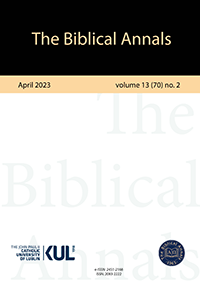Straniero ma non estraneo. Lo sfondo esperienziale e teologico della relazione con l’altro
Stranger but Not Extraneous. The Experiential and Theological Background of the Relationship with the Other
Author(s): Daniela De PanfilisSubject(s): Christian Theology and Religion, Theology and Religion
Published by: Katolicki Uniwersytet Lubelski Jana Pawła II - Wydział Teologii
Keywords: Social Identity Approach; Proximate Other; gēr; biblical Law; motive clauses; Gen 46–47; Exod 1:1–11
Summary/Abstract: The theme of the “stranger” in the Bible will be approached from the point of view of the relationship between an indigenous group and the “otherness” represented by those who sojourn in a foreign land. The words that the Hebrew language uses for “stranger” testifies to a nuanced perception of this overall category and also a nuanced attitude toward different kinds of “strangers.” The methodology applied is the Social Identity Approach, that focuses on intergroup relationship, and, the concept of Proximate Other. Among the “others,” the biblical Laws’ corpora give particular attention to gēr. The gēr is “other,” but he/she dwells within the Israelite in-group and shares with it his/her everyday life. Nine rules add a motive clause which refers to the experiential background of Jacob’s clan in Egypt. Four of these motive clauses refer to Israelites as gērim and come at the end of rules about only the gēr in Israel’s land. The theological background is expressed in Lev 25:23, which uses the word gērim for the relationship between God and his people. The proposal of the Bible is to bring near the “stranger,” so that the “stranger” is not more an “extraneous.”
Journal: The Biblical Annals
- Issue Year: 13/2023
- Issue No: 70/2
- Page Range: 201-224
- Page Count: 24
- Language: Italian

